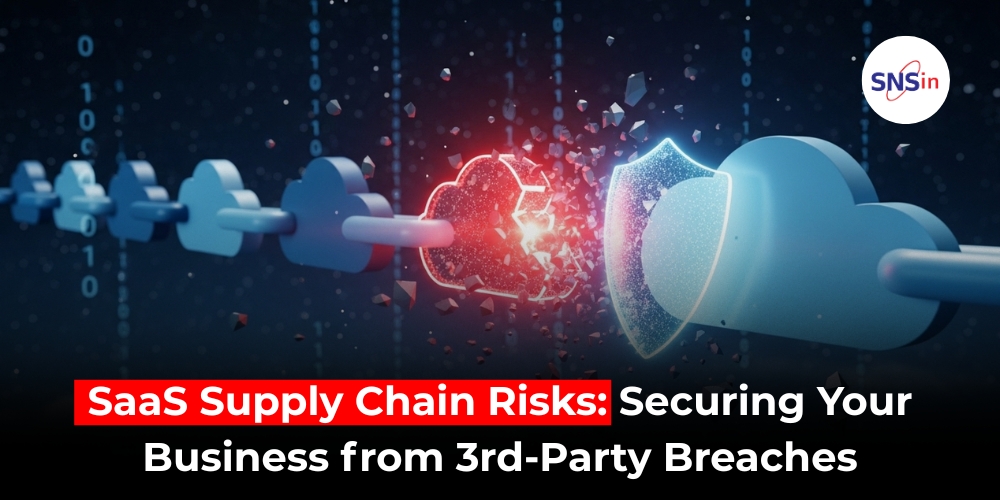The Backdoor You Forgot Was Open
Imagine this.
You’ve secured your office with biometric scanners, encrypted your servers, and trained your employees to dodge phishing emails like digital ninjas. Your CIO is finally breathing easy.
Then…BOOM. Your customer database is compromised.
But here’s the kicker – it wasn’t even your fault.
The breach came through a SaaS vendor. One you trusted. One you never thought to question.
Welcome to the era of SaaS supply chain risks, where your data is only as safe as the least secure app in your tech stack.
SaaS: The Modern Business Lifeline (and Achilles Heel):
In 2025, your business doesn’t just use SaaS — it runs on it.
From CRMs like Salesforce, project tools like Asana, to finance apps like Zoho and HR suites like Freshteam — your daily operations are stitched together by third-party software. Convenient? Absolutely. Secure? Well… not always.
According to Gartner, by 2025, 60% of organizations will use third-party SaaS tools to handle critical business operations — up from 30% in 2020.
But here’s the rub — 43% of data breaches in 2023 involved a third-party vendor.
(IBM X-Force Threat Intelligence Index 2024)
The takeaway? SaaS has become a double-edged sword. When your vendors are breached, you bleed.
The “SolarWinds Effect” and Beyond:
Let’s rewind to 2020. The infamous SolarWinds hack compromised over 18,000 organizations — including Microsoft, Cisco, and multiple U.S. government agencies. The attackers didn’t need to attack each company. They simply breached one — SolarWinds — and rode piggyback into others via software updates.
“It’s no longer about who has the best locks. It’s about who shares keys with whom.”
Nicole Perlroth, New York Times cybersecurity reporter
Since then, attacks through third-party software have only multiplied.
In India, the 2023 Aadhaar eKYC leak was traced back to a third-party vendor managing access APIs. Over 9 crore citizens’ data was at risk.
Why B2B Firms Are Sitting Ducks:
You might think — “We’re not a bank or a unicorn startup. Why would hackers target us?”
Here’s why:
- SaaS means shared responsibility. Most breaches exploit unclear accountability between client and vendor.
- Smaller firms are more likely to use unvetted SaaS tools.
- Customer data, vendor lists, financials — all flowing through SaaS pipes, often unmonitored.
A 2024 Verizon DBIR report found that third-party supply chain attacks rose by 40%, with SaaS vendors being the most common entry point.
Real-World Case: A B2B Startup’s SaaS Slip-Up:
A fintech SaaS company in Bengaluru discovered that a design plugin used by its product team had been compromised. While it seemed trivial, the plugin had OAuth access to the company’s internal documentation tool — exposing product roadmaps, sensitive credentials, and client info.
Damage? Over ₹2 crore in incident response and lost contracts.
Lesson? Even a harmless design tool can become a Trojan horse.
So, What Can You Do?
Here’s the good news: SaaS risks can be managed — with awareness, process, and proactive defense.
1. Inventory Your SaaS Stack (You’ll Be Shocked):
Most companies underestimate how many third-party apps are connected to their core systems.
Start by mapping:
- All SaaS tools used across departments
- Their permissions and data access
- Expired or orphaned accounts
- Tools like SaaS Alerts or Zylo can help automate this.
2. Adopt the Principle of Least Privilege:
Does your social media tool need access to your financial data?
Probably not.
Limit permissions. Use role-based access controls (RBAC). Regularly audit what’s been granted vs. what’s actually needed.
3. Assess Vendors Before You Marry Them:
Every new SaaS tool is a new door into your system.
Before onboarding:
- Ask for their SOC 2 or ISO 27001 compliance
- Evaluate breach history
- Check how they store, encrypt, and transmit your data
- Confirm if they sub-contract any processes
“Every third-party SaaS should go through the same scrutiny as a new hire.”
— Kunal Bahl, Co-founder, Snapdeal
4. Enable Logging and Continuous Monitoring:
Use a SIEM (Security Information and Event Management) system to monitor access and flag anomalies across SaaS apps. Tools like Splunk, LogRhythm, and Sentry integrate seamlessly with most cloud services.
5. Plan for the Worst: Incident Response Is Key:
Don’t just hope your SaaS provider never gets breached — prepare for when they do.
Your IR plan should include:
- Whom to notify
- What systems to isolate
- How to maintain continuity
- A clear communications plan (internal + external)
The Cost of Doing Nothing:
- The average cost of a supply chain attack in 2024: $4.5 million
- 60% of SMEs closed shop within 6 months of a major cyber breach
- Only 23% of Indian mid-sized businesses have third-party breach plans in place
How SNS India Secures Your SaaS Supply Chain:
At SNS India, we go beyond antivirus and firewalls. We help B2B businesses:
- Vet and onboard SaaS vendors securely
- Build Zero Trust SaaS environments
- Monitor and manage third-party risk exposure
- Develop customized IR and SaaS breach playbooks
- Stay compliant with DPDP and global data laws
Final Thoughts: Trust, But Always Verify:
SaaS is the future — that’s a given. But so are increasingly clever, layered, and invisible attacks.
As your digital ecosystem grows, don’t just protect your house protect every wire, pipe, and doorway connected to it. Because in 2025, your weakest link might just be someone else’s software.
“You can outsource services. You can’t outsource risk.”
— Bruce Schneier, cybersecurity expert
Let’s make sure the apps that make you efficient don’t also make you vulnerable.
Secure smarter. Trust carefully. Audit always.
Talk to SNS India for a Network or SaaS security assessment today. Reach out to [email protected] for more information on how to cybersecure your company.
Author
NK Mehta
![]()




